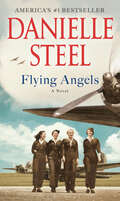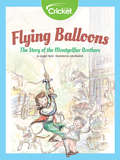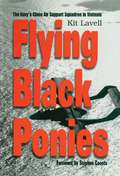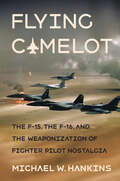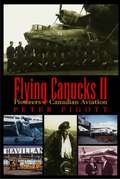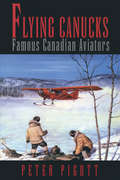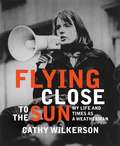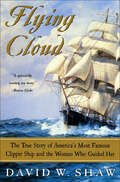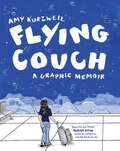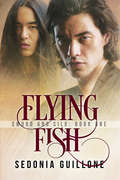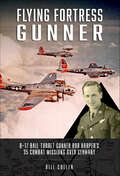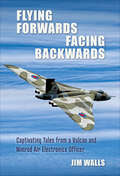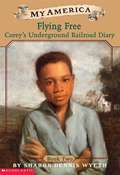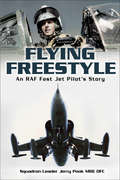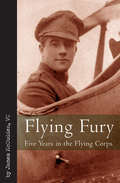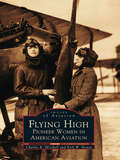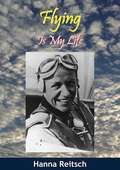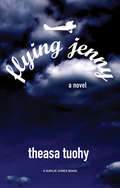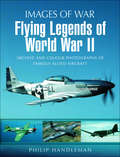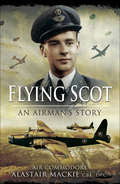- Table View
- List View
Flying Angels: A Novel
by Danielle SteelWorld War II brings together six remarkable young flight nurses, who face the challenges of war and its many heartbreaks and victories as unsung heroes, in this inspiring novel from #1 New York Times bestselling author Danielle Steel. <P><P>Audrey Parker’s life changes forever when Pearl Harbor is attacked on December 7, 1941. Her brother, a talented young Navy pilot, had been stationed there, poised to fulfill their late father’s distinguished legacy. Fresh out of nursing school with a passion and a born gift for helping others, both Audrey and her friend Lizzie suddenly find their nation on the brink of war. <P><P>Driven to do whatever they can to serve, they enlist in the Army and embark on a new adventure as flight nurses. Risking their lives on perilous missions, they join the elite Medical Air Evacuation Transport Squadron and fly into enemy territory almost daily to rescue wounded soldiers from the battlefield. <P><P>Audrey and Lizzie make enormous sacrifices to save lives alongside an extraordinary group of nurses: Alex, who longs to make a difference in the world; Louise, a bright mind who faced racial prejudice growing up in the South; Pru, a selfless leader with a heart of gold; and Emma, whose confidence and grit push her to put everything on the line for her patients. <P><P>Even knowing they will not achieve any rank and will receive little pay for their efforts, the “Flying Angels” will give their all in the fight for freedom. They serve as bravely and tirelessly as the men they rescue on the front lines, in daring airlifts, and are eternally bound by their loyalty to one another. Danielle Steel presents a sweeping, stunning tribute to these incredibly courageous women, inspiring symbols of bravery and valor. <P><P><b>A New York Times Best Seller</b>
Flying Balloons: The Story of the Montgolfier Brothers
by Joseph TaylorDid you know hot air balloons were dreamed up by a French boy in the 1700s? Joseph Montgolfier devoted his life to experiments that he hoped would allow him to fly. With the help of his little brother, his invention allowed humans to fly for the first time in history!
Flying Black Ponies
by Kit LavellThe tragic, the comic, the terrifying, the poignant are all part of the story of the Black Pony pilots who distinguished themselves in the Mekong Delta during the Vietnam War. Flying their turboprop Broncos down and dirty, low and slow, they killed more of the enemy and saved more allied lives with close-air support than all the other naval squadrons combined during the three years they saw action. Author Kit Lavell was part of this squadron of black sheep given a chance to make something of themselves flying these dangerous missions. The U.S. Navy's only land-based attack squadron, Light Attack Squadron Four (VAL-4) flew support missions for the counter insurgency forces, SEALs, and allied units in borrowed, propeller-driven OV-10s. For fixed-wing aircraft they were dangerous, unorthodox missions, a fact readers quickly come to appreciate.
Flying Camelot: The F-15, the F-16, and the Weaponization of Fighter Pilot Nostalgia (Battlegrounds: Cornell Studies in Military History)
by Michael W. HankinsFlying Camelot brings us back to the post-Vietnam era, when the US Air Force launched two new, state-of-the art fighter aircraft: the F-15 Eagle and the F-16 Fighting Falcon. It was an era when debates about aircraft superiority went public—and these were not uncontested discussions. Michael W. Hankins delves deep into the fighter pilot culture that gave rise to both designs, showing how a small but vocal group of pilots, engineers, and analysts in the Department of Defense weaponized their own culture to affect technological development and larger political change.The design and advancement of the F-15 and F-16 reflected this group's nostalgic desire to recapture the best of World War I air combat. Known as the "Fighter Mafia," and later growing into the media savvy political powerhouse "Reform Movement," it believed that American weapons systems were too complicated and expensive, and thus vulnerable. The group's leader was Colonel John Boyd, a contentious former fighter pilot heralded as a messianic figure by many in its ranks. He and his group advocated for a shift in focus from the multi-role interceptors the Air Force had designed in the early Cold War towards specialized air-to-air combat dogfighters. Their influence stretched beyond design and into larger politicized debates about US national security, debates that still resonate today. A biography of fighter pilot culture and the nostalgia that drove decision-making, Flying Camelot deftly engages both popular culture and archives to animate the movement that shook the foundations of the Pentagon and Congress.
Flying Canucks II: Pioneers of Canadian Aviation
by Peter PigottAmong the many technological advances of this century that have shrunk our country, few have had as great an impact as aviation. Technologies evolve and national priorities change, but the qualities necessary to design aircraft, fly them in war and peace, and manage airlines remain constant. In this, his second book about pioneers of Canadian aviation, Peter Pigott brings a richness and understanding of the individuals themselves to the reader. Flying Canucks II takes us into Air Canada’s boardroom with Claude I. Taylor, to the Avro Arrow design office with Jim Floyd, inside the incredible career of Aviation Hall of Fame pilot Herb Seagram, on C.D. Howe’s historic dawn-to-dusk flight, and with Len Birchall in a Stranraer seaplane before he became, in Churchill’s phrase, “The Saviour of Ceylon.” It includes the story of how Scottish immigrant J.A. Wilson engineered a chain of airports across the country, how bush pilot Bob Randall explored the polar regions, and the ordeal of Erroll Boyd, the first Canadian to fly the Atlantic. The lives of “Buck” McNair and “Bus” Davey, half a century after the Second World War, are placed in the perspective of the entire national experience in those years. Whenever possible, Mr. Pigott has interviewed the players themselves, and drawing on his experience and contacts within the aviation community, has created a multi-faceted study of the business, politics, and technology that influenced the ten lives explored in depth in this book. C.D. Howe, wartime Canada’s absolute government czar used to say that running the country’s airline was all he really wanted to do. With a rich aviation heritage such as this, Flying Canucks II depicts the elements and the enemy at their worst and the pioneers of Canadian aviation at their best.
Flying Canucks: Famous Canadian Aviators
by Peter PigottFlying Canucks tells the fascinating story of aviation in Canada through this collection of 37 biographies of important aviators in our nation’s history. As early as 1908, having read the Wright brothers’ invention, Alberta farm boys and mechanics in Quebec villages were constructing large kites, attempting to fly them. Within a decade, Canadian air aces, like Bishop and Barker, swept the wartime skies over Frances, piloting deadly machines in mortal combat. Through the 20s, that very Canadian breed of adventurer, the bush pilot, ventured over the desolate tundra, delivering medicine and missionaries, mail and Mounties to remote communities as far as Ellesmere Island and Ungava Bay. Members of the Royal Canadian Air Force fought with distinction during the Second world War. Titles such as The Saviour of London and The Angel of Ceylon seem like wartime hype, but the skill and courage that those pilots displayed half a century ago set them apart still. For the six Canadian airmen who won the Victoria Cross, there were thousands who flew into the meat grinder that was the Allies’ strategic air offensive over Europe. This book chronicles the exploits of only a few men and women – but it truly celebrates the spirit and resolve of countless brave Canadians who are proud part of aviation in this country.
Flying Close to the Sun: My Life and Times as a Weatherman
by Cathy WilkersonFlying Close to the Sun is the stunning memoir of a white middle-class girl from Connecticut who became a member of the Weather Underground, one of the most notorious groups of the 1960s. Cathy Wilkerson, who famously escaped the Greenwich Village townhouse explosion, here wrestles with thelegacy of the movement, at times finding contradictions that many others have avoided: the absence of women's voices then, and in the retelling; the incompetence and the egos; the hundreds of bombs detonated in protest which caused little loss of life but which were also ineffective in fomenting revolution. In searching for new paradigms for change, Wilkerson asserts with brave humanity and confessional honesty an assessment of her past--of those heady, iconic times--and somehow finds hope and faith in a world that at times seems to offer neither.
Flying Cloud: The True Story of America's Most Famous Clipper Ship and the Woman Who Guided Her
by David W. Shaw“Details the record-breaking 1851 New York-to-San Francisco voyages of the clipper ship Flying Cloud, focusing on its navigator, Eleanor Creesy.” —Library JournalIn 1851, navigator Eleanor Creesy set sail on the maiden voyage of the clipper ship Flying Cloud, traveling from New York to San Francisco in only eighty-nine days. This swift passage set a world record that went unbroken for more than a century. Illustrated with original maps and charts as well as historical photographs, Shaw’s compelling narrative captures the drama of this thrilling adventure.In a position almost unheard of for a woman in the mid-nineteenth century, Eleanor Creesy served as the ship’s navigator. With only the sun, planets, and stars to guide her, she brought Flying Cloud safely around Cape Horn at the height of a winter blizzard, faced storms, dodged shoals, and found her way through calms to make the swift passage possible. Along with her husband, Josiah, the ship’s captain, she sailed the mighty 3-masted clipper through 16,000 miles of the fiercest, most unpredictable oceans in the world.Shaw vividly recreates nineteenth-century seafaring conditions and customs, for both the crew and the passengers who entrusted their fate to an untested ship. Including excerpts from letters and diaries of passengers, Shaw recounts Flying Cloud’s victory in the face of adversity—including sabotage, insubordination, and severe damage to the clipper’s mainmast that might have sunk her with all hands lost. But the ship triumphed and would ultimately sail the world. Flying Cloud brings to life, for the first time, the glory of one of America’s most important seafaring tales and one woman’s incredible achievements.
Flying Colours (The Hornblower Saga, Book #3)
by C. S. ForesterIn Flying Colors, Captain Horatio Hornblower finds himself captured by the French and ordered executed by Napoleon Bonaparte himself. The unflappable Hornblower however plans a daring escape with the help of Lieutenant Bush and French Royalists.
Flying Couch: A Graphic Memoir
by Amy KurzweilFlying Couch, Amy Kurzweil's debut, tells the stories of three unforgettable women. Amy weaves her own coming-of-age as a young Jewish artist into the narrative of her mother, a therapist, and Bubbe, her grandmother, a World War II survivor who escaped from the Warsaw Ghetto by disguising herself as a gentile. Captivated by Bubbe's story, Amy turns to her sketchbooks, teaching herself to draw as a way to cope with what she discovers. <p><p> Entwining the voices and histories of these three wise, hilarious, and very different women, Amy creates a portrait not only of what it means to be part of a family, but also of how each generation bears the imprint of the past. <p> A retelling of the inherited Holocaust narrative now two generations removed, Flying Couch uses Bubbe's real testimony to investigate the legacy of trauma, the magic of family stories, and the meaning of home. With her playful, idiosyncratic sensibility, Amy traces the way our memories and our families shape who we become. The result is this bold illustrated memoir, both an original coming-of-age story and an important entry into the literature of the Holocaust. <p> <i>Advisory: Bookshare has learned that this book offers only partial accessibility. We have kept it in the collection because it is useful for some of our members. To explore further access options with us, please contact us through the Book Quality link on the right sidebar. Benetech is actively working on projects to improve accessibility issues such as these.</i>
Flying Crows: A Novel
by Jim LehrerWith Flying Crows, veteran newsman and bestselling author Jim Lehrer has written his most powerful novel, a work that moves masterfully from past to present and back again to solve the mystery that is American mayhem.<P> In 1997, police discover an old homeless man in the Kansas City train station. “Birdie Carlucci” claims he has lived there since 1933, hiding out in the storeroom of a Harvey House restaurant. Kansas City cop Lieutenant Randy Benton decides to discover the truth behind Birdie’ s tale—and finds himself on a ride that leads ever backward into our country’s bloodstained past.<P> Benton’s investigation reveals the story of young Birdie, incarcerated in a brutal insane asylum where the preferred method of treatment is beating with a baseball bat. In that hopeless environment, though, he’s befriended by another patient, Josh Lancaster, once dismissed as a lost cause but snatched back from the brink by a compassionate doctor. But what is the secret of Lancaster’s involvement in an infamous Civil War encounter between Confederate bushwhackers and Union soldiers? And what truly happened after Birdie escaped from the asylum on the famous Flying Crow train?<P> As Benton returns to the present day, he wonders: How much, if any of it, really took place? What were the true public and private traumas of these two troubled men who can’t forget what they’ve seen or merely imagined?<P> Inspired by real events, Flying Crows is a novel that moves as inexorably as a train in the night to a shattering conclusion—one that reveals the many meanings of imprisonment and escape, and all the eccentricities and tragedies of the American soul.
Flying Fish (Sword and Silk #1)
by Sedonia Guillone2nd EditionSword and Silk: Book OneIn eighteenth century Japan, during the golden age of samurai and of the Kabuki theater, young actors known as "flying fish" traveled the countryside, performing for audiences by day and giving their bodies to their samurai patrons at night. Genji Sakura is one such flying fish, yet he dreams of finding the man he can give his heart to and leave the loneliness of his itinerant life behind. Though he loves theater, he doesn't love every part of his profession, especially some of the patrons. So when a handsome ronin comes upon him stealing some solitude for a bath in a hot spring and their encounter turns passionate, Genji's surprised and delighted. Daisuke Minamoto's past fills his life with a bitterness that grips his soul and makes him dangerous. Yet passion takes him when he spies on a graceful young man bathing naked in a hot spring. He has always loved women, but he can't deny the call of his heart. After an afternoon of sexual bliss, his heart and soul are tormented and torn. Keeping this miraculous lover will require giving up the one thing that has kept him alive for years: his hatred for the lord who murdered his wife. If he loves another, how will he go on and who will he become?A Timeless Dreams title: While reaction to same-sex relationships throughout time and across cultures has not always been positive, these stories celebrate M/M love in a manner that may address, minimize, or ignore historical stigma.First Edition published by Loose ID LLC, 2009.
Flying Fortress Gunner: B-17 Ball Turret Gunner Bob Harper's 35 Combat Missions over Germany
by Bill CullenThe biography of Bob Harper, a B-17 ball turret gunner with the 8th Air Force who survived 35 combat missions over Germany in WWII, and was shot down twice. At 5 feet, 4 inches tall and weighing just 110 pounds, Bob Harper was below the minimum size requirements for US military service. As the demand for manpower increased, rules were bent, Harper’s deferment was retracted, and he was drafted into the Army. Harper was deployed to the European front and survived 35 combat missions as a B-17 ball turret gunner. Based at airfields in England, Bob and the 381st Bomb Group flew brutal missions over heavily defended industrial centers in Germany. Harper was shot down twice and awarded the Distinguished Flying Cross. Through his letters home, combat reports, and extensive interviews with author Bill Cullen, Harper describes his harrowing experiences on board the Flying Fortresses of the Eighth Air Force. Cullen’s interviews with Harper took place over a period of years, and it is the anecdotes from the interviews that drive the majority of the narrative. The ball turret was located underneath the aircraft and was a confined, intense, and unique environment from which to experience combat during the Second World War. Readers will find Harper, who went on to a successful business career after the war, to be an insightful, witty, and engaging storyteller.
Flying Fortress: The Illustrated Biography of the B-17s and the Men Who Flew Them
by Edward JablonskiRenowned throughout the world for its strength and destructiveness, the Flying Fortress was one of the greatest fighting airplanes of all time. In this comprehensively documented biography, Edward Jablonski tells the story of the Flying Fortress Boeing B-17, America’s legendary long-range bomber. From the B-17's near death in infancy to the emergence of its successor, the Superfortress, Flying Fortress captures the exhilarating career of the B-17 with thrilling accounts of the exploits of these planes and their pilots. In this unforgettable history, Jablonski details the Fortress’s role in the strategic and tactical issues of air war, and chronicles the B-17’s roles in famous raids including Regensburg, Marienburg, Munster, Schweinfurt, Dresden, and Berlin, along with its part in great battles, such as D-Day. Masterfully written, Flying Fortress is a classic in aviation literature with over 400 illustrations (many unpublished action photos) in addition to a section on the design of the Flying Fortress, which includes a number of detailed cutaway drawings. Approximately 60 pages from the Flying Fortress’s Piloting Manual are also featured herein. Find out why the Flying Fortress ultimately redefined the concept of war.
Flying Forwards, Facing Backwards: Captivating Tales from a Vulcan and Nimrod Air Electronics Operator
by Jim WallsSince he was a child in the 1950s watching Vampires and Meteors operating from RAF Turnhouse, Jim Walls wanted to fly aircraft, he just never envisaged that his flying career would be spent in the back seat as opposed to the front. Jim guides readers through his 40-year RAF career that started as a Boy Entrant at RAF Cosford, then as an air radar tradesman, before specializing as an air electronics operator (AEOp) in the Nimrod MR1, and later as an air electronics officer (AEO) who flew in Nimrod R1s and Vulcan B2s. With detailed insight into the world of radar, electronic countermeasures, and signals intelligence, Jim highlights the role they played in warfare for numerous operations during the Cold War as well as the Falklands campaign, First Gulf War, and Bosnian War. He also recalls the peacetime role of the Nimrod and Vulcan with stories from his time on 51, 120, and 617 Squadrons. As well as focusing on his career, Jim gives his viewpoint on matters such as Operation Black Buck and the reduced war-fighting capability of the Vulcan as it neared retirement. This fascinating book showcases the vital role that AEOs held and the importance of radar and electronic warfare in the fight against enemy forces. It is also a tribute to the much-loved Cold War icons, the Nimrod and the Vulcan. With photography throughout, mainly from the author’s personal collection, this book will appeal to Cold War enthusiasts and fans of the iconic jets of that era.
Flying Fox: Otto Fuchs: A German Aviator’s Story, 1917–1918
by Adam M. WaitUnique personal history of the Imperial German Air Service
Flying Free: Corey's Underground Railroad Diary, Book 2 (My America)
by Sharon Dennis WyethCorey and his family have escaped from slavery and the South and are now living in Canada. They own their own land, have made new friends, and Corey gets to go to school. But danger still remains across the river in Ohio, where slave-catchers lurk, waiting to capture escaped slaves to bring them back to their former masters.
Flying Freestyle: An RAF Fast Jet Pilot's Story
by Jerry PookA British Royal Air Force pilot recounts his 25-year career in the cockpit during the Cold War in this military memoir. During a twenty-five-year flying career in the RAF, Jerry Pook has flown Hunter Fighter/Ground Attack aircraft in the Gulf, Harriers in West Germany, the supersonic Starfighter with the Dutch Air Force, the Harrier in Belize, Central America and the Tornado bomber at the Tri-national Tornado Training Establishment where he trained German and Italian pilots and navigators. Jerry had a long relationship with the Harrier Fighter/Ground Attack vertical take-off aircraft. This he flew in West Germany at the height of the Cold War operating from Wildenrath and off-base operations with Field Wing operations based in the fields and woods of the German countryside. Jerry saw action during the Falklands War when based on HMS Hermes and flying one of the few RAF Harriers in the Ground Attack role in support of the troops fighting ashore. He then enjoyed flying the American-built Starfighter RF 104G during a three-year exchange tour with the Dutch Air Force—he describes the Starfighter as &“beautiful to fly, smooth and sophisticated, supremely fast and powerful—if you took liberties with it you knew it would kill you in an instant.&” After three years with No 1 (Fighter) Squadron and again flying the Harrier, he moved to the then new Tornado, flying in its bomber role. This he continued to fly operationally and in the instructional role for thirteen years until grounded from military flying for medical reasons.
Flying Fury: Five Years in the Royal Flying Corps (Vintage Aviation Library)
by James B. McCuddenThe day-to-day insights of a brilliantly daring World War I ace that only ends with his death at the age of 23 . . . James McCudden was an outstanding British fighter ace of World War I, whose daring exploits earned him a tremendous reputation and, ultimately, an untimely end. Here, in this unique and gripping firsthand account, he brings to life some of aviation history&’s most dramatic episodes in a memoir completed at the age of twenty-three, just days before his tragic death. During his time in France with the Royal Flying Corps from 1914 to 1918, McCudden rose from mechanic to pilot and flight commander. Following his first kill in September 1916, McCudden shot down a total of fifty-seven enemy planes, including a remarkable three in a single minute in January 1918. A dashing patrol leader, he combined courage, loyalty, and judgment, studying the habits and psychology of enemy pilots and stalking them with patience and tenacity. Written with modesty and frankness, yet acutely perceptive, Flying Fury is both a valuable insight into the world of early aviation and a powerful account of courage and survival above the mud and trenches of Flanders. Fighter ace James McCudden died in July 1918, after engine failure caused his plane to crash just four months before the end of World War I. His success as one of Britain&’s deadliest pilots earned him the Victoria Cross.
Flying High: Pioneer Women in American Aviation (Images of Aviation)
by Kirk W. House Charles R. MitchellIn the beginning of the twentieth century, women weredemanding more freedom. What could bring more freedomthan a chance to fly? Women went up in those early wire-andfabric contraptions to gain independence, to make money, or to make their names as pilots. They sought to prove that women pilots could do just as well as men--and some did far better. Flying High: Pioneer Women in American Aviation tells the story of Blanche Stuart Scott, who made $5,000 a week andbroke forty-one bones; of Harriet Quimby, who flew the English Channel handily and then fell to her death in five feet of water near Boston Harbor; of Ruth Law and Katherine Stinson, who set American distance flying records--all before any of them were allowed to vote. Flying High: Pioneer Women in American Aviation also tells the tales of women behind the scenes--the financiers, engineers, and factory workers--from the earliest days of flying to victory in World War II. These stories of the first female flyers are told in rare, vintage photographs, many previously unpublished, from the archives of the Glenn H. Curtiss Museum.
Flying Is My Life [Illustrated Edition]
by Hanna Reitsch Lawrence Roy WilsonIncludes the Aerial Warfare In Europe During World War II illustrations pack with over 200 maps, plans, and photos.Hanna Reitsch is unusual in being a feminine woman who was yet the equal of men in a dangerous male profession -- test-piloting new military aircraft. Her love of flying from childhood on, along with her superior intelligence, determination, and ability to withstand tremendous stresses, gave her the edge that allowed her to rise to the top of the aviation world.Hanna Reitsch offered her gifts to the German nation in the same way that Adolf Hitler and many others did -- with a complete giving of herself and her abilities, holding nothing back. Although she lived to 1979, she never renounced her participation with the National Socialist government or criticized Hitler, even under pressure to do so. Hanna's life story is an amazing one that sounds almost unbelievable in its drama and acts of heroism. She never married or had children; instead she occupied herself with the two burning loves of her life -- flying and the salvation of her beloved Fatherland in its time of need.
Flying Jenny
by Theasa Tuohy&“[A] superb new historical novel . . . about the heady late 1920s, when the public went crazy every day over barnstorming pilots and their heroic stunts.&”—Publishers Daily Reviews People are doing all sorts of screwy things in 1929. It is a time of hope, boundless optimism, and prosperity. &“Blue Skies&” is the song on everyone&’s lips. The tabloids are full of flagpole sitters, flappers, and marathon dancers. Ever since Charles Lindbergh flew across the Atlantic solo, the entire world has gone nuts over flying. But everyone agrees that the stunt pilots take the cake. Jenny Flynn defies the odds and conventions in her pursuit of the sky. She attracts the attention of Laura Bailey, a brash reporter crashing through her own glass ceiling at a New York City newspaper. Laura chases the pilot&’s story—and the truth about her own mysterious father—on a barnstorming escapade from Manhattan to the Midwest.Flying Jenny offers a vivid portrait of an earlier time when airplanes drew swarming crowds entranced by the pioneers—male and female—of flight. Finalist for the Oklahoma Book Awards, Fiction &“[A] romp through the early days of women&’s aviation history . . . Debutante pilot Jenny Flynn and cub reporter Laura Bailey carry the spunk of Thelma & Louise to new heights as they fight for space in the cockpit and the city room.&”—Janet Groth, author of The Receptionist: An Education at The New Yorker &“Tuohy uses both Jenny and Laura to explore gender roles in the late 1920s and how two young women push their own boundaries as well as the society around them.&”—Historical Novels Review
Flying Legends of World War II: Archive and Colour Photos of Famous Allied Aircraft (Images of War)
by Philip HandlemanMore than thirty Allied Forces' WWII aircraft types are illustrated in many rare and previously unpublished black and white and color photographs. Each type is described giving vital data on development history, combat record, famous pilots and significant air battles. Performance, range and weapon loads are also included. The unique color photographs are from the collection of the late William B. Slate, an aviation photographer who strove to capture the thrilling perspective that can only come from close-up, in-flight vantage points from an aircraft flying in formation.
Flying Scot: An Airman’s Story
by Alastair Mackie"This is the memoir of a 26 year career in the RAF, told with humor and modesty that belies the danger of flying over 47 different types of military aircraft in war and peace. Alastair Mackie began his operational career flying Wellington bombers over the North African desert war until converting to the B-24 Liberator. He watched the famous opening barrage at the opening of El Alamein from the air and became involved in supplying the besieged island of Malta together with hunting German ships in the Mediterranean. He was then posted to Northern Ireland converting to the DC-3. He flew during D-Day, dropping parachute troops into German held territory and continued these operations until the wars end when he was part of the operation to return British troops and released POWs to the UK. He was then posted to a long-range DC-3 squadron and flew to all points East.After the war he was posted to The Central Flying School teaching future flying instructors in a variety of aircraft from Tiger Moths to Lancasters. After a tour in the Far East where he flew his own personal Spitfire, he returned to the UK to convert to the jet aircraft then coming into service. After a spell desk bound on the Cabinet Office Joint Intelligence Committee, which he disliked, he was appointed Station Commander at Colerne which operated the Hastings transport aircraft. Alastair was then appointed wing commander in charge of flying at RAF Waddington. The job also gave him the charge of two resident Canberra bomber squadrons, Nos. 37 and 38. With them he was able to get plenty of flying in an aircraft he loved. After retiring from the RAF he commenced a career in Law and in his later years he has become a firm opponent of Britains nuclear deterrent, having seen its preparation with the Vulcan Force until the Royal Navy assumed the role it now has. "
Flying Scotsman: A Pictorial History
by Keith Langston Fred KerrBuilt at Doncaster works in 1923 the Nigel Gresley designed then-A1 class Pacific (4-6-2) first entered service as No 1472. The new locomotive did not receive a name until it was sent for display at a Wembley exhibition in 1924, and then the name Fying Scotsman was chosen. The Legend was born. In 1928 the London North Eastern Railway (LNER) express steam locomotive hauled the first nonstop service from London to Edinburgh and in 1934 went on to break through the 100mph barrier.In addition to regularly hauling express trains for the LNER and later British Railways (BR), the Gresley steam icon has also traveled to, and worked passenger trains in, North America and Australia. Withdrawn by BR in January 1963 as BR No 60103, the locomotive was bought for preservation and soon became a regular sight on mainline specials and at preserved railways. The locomotives history in preservation is an interesting if not chequered one, however stability is now assured as Flying Scotsman has rightly become a part of the national collection administered by the National Railway Museum (NRM). The excitement which surrounded the return to steam of Flying Scotsman in 2016, and the ongoing celebrity status afforded to the famous Gresley designed engine, are perchance confirmation of the fact that it is The Worlds Most Famous Steam Locomotive. The most famous phrase entered into locomotive preservation folklore when first broadcast by John Noakes, a BBC TV Blue Peter presenter. A great many words have been written about the engineering specification and in service performance of Flying Scotsman. Accordingly, this keepsake publication simply uses carefully selected images, dating from the BR steam era to the present day, to celebrate the Return of the Legend. This publication includes a selection of QR Codes with links to items of film footage.
